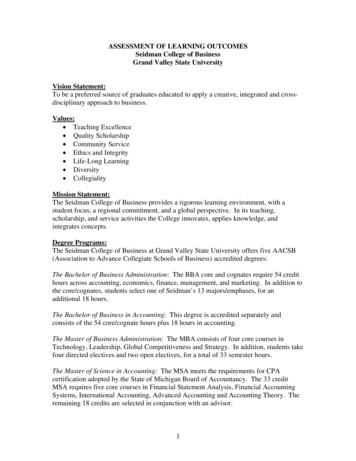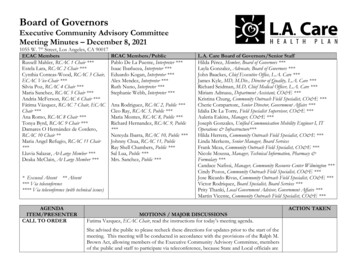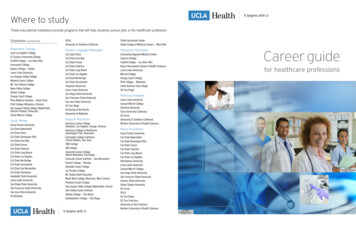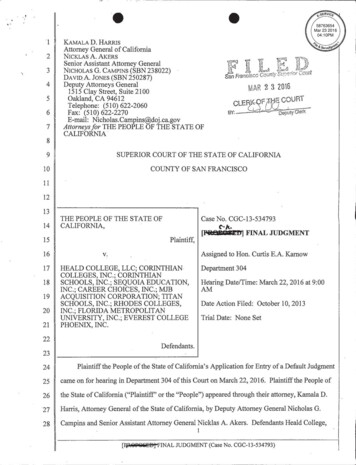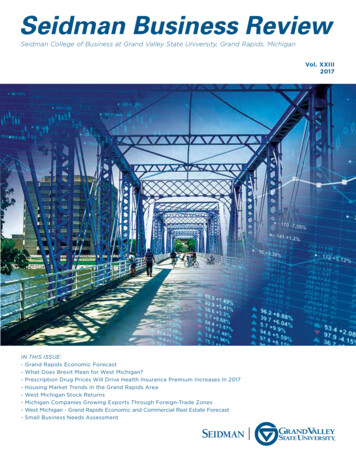
Transcription
Seidman College of Business at Grand Valley State University, Grand Rapids, MichiganVol. XXIII2017IN THIS ISSUE:- Grand Rapids Economic Forecast- What Does Brexit Mean for West Michigan?- Prescription Drug Prices Will Drive Health Insurance Premium Increases In 2017- Housing Market Trends In the Grand Rapids Area- West Michigan Stock Returns- Michigan Companies Growing Exports Through Foreign-Trade Zones- West Michigan - Grand Rapids Economic and Commercial Real Estate Forecast- Small Business Needs Assessment
Seidman Business CentersService and Research outreach to the Greater Grand RapidsBusiness CommunityCenter for Leadership & Corporate Education616.331.7246 www.gvsu.edu/leaders Leadership development and training Leading high performance teams Customized offerings tailored to businessFamily Owned Business Institute616.331.7200 www.gvsu.edu/fobi Research Family business resource center Family business courseworkKoeze Business Ethics Initiative616.331.7468 www.gvsu.edu/business/ethics Ethics Consulting – Values Clarification, Conflict,and Curriculum Research and Publication in Business Ethics Providing Notable Speakers and Facilitators in theField of Ethics for the West Michigan CommunityMichigan Small Business Development Center616.331.7370 www.sbdcmichigan.org/ One-on-one Counseling Business Education Secondary Market Research Technology CommercializationState Office Michigan Small BusinessDevelopment Center616.331.7480 www.sbdcmichigan.org Business Plan Development Market Research Accessing Capital Business Workshops Technology Commercialization Financial Management Export Strategy Strategic PlanningRichard M. and Helen DeVosCenter for Entrepreneurship & Innovation616-331-7582 www.gvsu.edu/cei Micro Lending Competitions and Early Stage Funding Entrepreneurial Talent Development and Education Mentoring and CoachingVan Andel Global Trade Center616.331.6811 www.vagtc.org International Market Research & Business Resources Import/Export Compliance Assistance Import/Export Technical Training & Events Language Translation and Culture AssistanceEducational Opportunitiesoffered by theSeidman College of BusinessBachelor of Business Administration (BBA) Accounting Business Economics —Emphasis in Real Estate Entrepreneurship Finance General Business General Management Human Resources Management International Business Management—Emphasis in MIS Operations Management Marketing — Emphases in Distribution and Logistics,and Sales Supply Chain ManagementBachelor of Arts (BA) or Bachelor of Science (BS) in EconomicsMaster of Business Administration (MBA) Executive MBA Evening MBAMaster of Science in Taxation (MST)Master of Science in Accounting (MSA)Seidman Business Review is an annual publicationof Grand Valley State University’s Seidman College ofBusiness, Grand Rapids, Michigan.e-mail: gvbizinfo@gvsu.eduEditor: Dr. Gerry Simons, Professor, Economics DepartmentCopy editor: Vonnie HerreraDesign and production: Kruse Design L.L.C. 2017 Grand Valley State University, Seidman College of BusinessCertificate Program TaxationNon-Credit Certificate Programs Certified Financial Planning (CFP)
From the Editor No matter what yourpolitical views, Ithink we can all agreethat 2016 was a wild, rollercoaster ride of a year, full ofsurprises, twists and turns,and loop-the-loops.The articles presented in thisedition of the Seidman BusinessReview aim to shed light onsome of the effects that thistumultuous year has alreadyhad on our economy, as wellas effects that are yet to come. The general economic situationis reflected in our yearly reviews and analyses of regionalstocks, housing markets, commercial real estate, and ourever-popular annual economic forecast. We also have specialistarticles on topics that are relevant to many in the businessworld – the high cost of prescription drugs, the importance offoreign-trade zones, assessing the needs of small businesses,and a piece by a British economist (yours truly!) on Brexit.It is my belief that you will find these articles interesting andinformative, with the insight and analysis that they provide.As always, I encourage you to look over the list of SeidmanFaculty Experts provided on the last page and to contactthose whose expertise may be of value to you, as our rollercoaster ride continues!Gerry Simons, Professor of EconomicsSeidman Business Review2017 Contents2Grand Rapids Economic Forecast 2017Paul Isely, Ph.D.How do area business leaders feel aboutthe economy? What are their projections foremployment, sales, and exports?6 What Does Brexit Mean for West Michigan?Gerry Simons, Ph.D.The British referendum to leave the EuropeanUnion will have far-reaching consequences. Whatare some of the key points for U.S. businesses?9 Prescription Drug Prices Will Drive HealthInsurance Premium Increases in 2017Jeff Rubleski, M.B.A.Find out about the role that prescription drugsplay in medical inflation. What can you and yourbusiness do to control these costs?11Housing Market Trends In the Grand Rapids AreaLaudo Ogura, Ph.D., and Paul Isely, Ph.D.Global economic growth was sluggish in2016, but there was decent growth in the U.S.economy. What were the effects on the localhousing market?14 West Michigan Stocks Again Led the Way in 2016Gregg Dimkoff, Ph.D.The U.S. stock market posted solid gains in2016, but how did the stocks of our regionalcompanies compare?18 Michigan Companies Growing Exports throughForeign-Trade ZonesSonja Johnson, B.S.Foreign-Trade Zones have many advantages forMichigan businesses. Find out how they might beuseful for you.West Michigan-Grand Rapids Economic and20 Commercial Real Estate ForecastJeff HainerThe commercial real estate market is complex.Find out what the experts at Colliers Internationalhave to say about the prospects for 2017.26 Small Business Needs AssessmentJennifer Deamud, M.P.A., M.S.Growing a business is always a challenge,but what are the specific issues facing smallbusinesses in Michigan?29 Seidman Faculty ExpertsA listing of the various areas of expertise ofSeidman College of Business faculty.
Grand Rapids Economic Forecast 2017Paul Isely, Ph.D., Department of Economics, Seidman College of Business The Current Business Confidence Index for 2016 is 78.3%, a small improvement over last year. The Forecast Business Confidence Index for 2017 is 80.7%. Employment is expected to grow by 2.0%-2.2% in 2017. Overall nominal sales are expected to increase by 2.8%-3.2% for 2017. Export growth in 2017 is forecast for continued weakness; expected growth is between 1.6% and 3.6% during 2017. All indicators signal the 2017 economy continuing to grow, but the pace, particularly in employment, will be slower than seen in 2016.IntroductionThe survey for the greaterGrand Rapids economy (Kent,Ottawa, Muskegon, and Allegancounties) was conducted inNovember and December 2016.A survey was mailed to theCEOs and business leaders forjust over 966 organizationsbased on a representativesample. We tried to ensurethat the sample representeddifferent sectors of the regionaleconomy and the geographicaldiversity of the area. Eventually,154 organizations responded, resulting in a response rate of16%, which is a little lower than previous years, but still largeenough to make inferences. However, due to possibilityof a non-random response sample, the survey should beinterpreted with caution. In addition, the survey was delayedtwo weeks this year to allow leaders more time to digest theresults of the presidential election.A few methodological considerations are in order. Althoughwe discuss the survey results in terms of averages, the dataare represented in a histogram format to show the entiredistribution of responses. The employment, sales, and exportnumbers are more volatile as raw averages (when calculatedwithout adjusting for outliers—responses beyond onestandard deviation). Since the average of a small sample issignificantly influenced by extreme numbers, we use theaverages without the outliers to provide more reliable results.The histograms, however, depict all the available observationsto show the broad picture.Confidence IndexThe confidence index has been tracked by researchers at theSeidman College of Business since 1995. A continuing goalof the survey is to historically track the overall businessconfidence of the Grand Rapids area with a confidence index.The confidence index respondents use a scale from zeropercent (no confidence at all) to one hundred percent(complete confidence). In response to the question: Howconfident are you in the regional economy? The averageresponses for the private sector and the government/non-profitsector over the last 21 years are shown in Figure 1.Figure 1: West Michigan Confidence Index Forecast 2017GovernmentAll Sectors Excluding c9.200D0ec.20D01ec.20Dec 02.200D3ec.2004Dec.20Dec 05.200D6ec.20Dec 07.20Dec 08.200D9ec.201Nov 0.201N1ov.20Nov 12.20Nov 13.20Nov 199560Seidman Business Review 2017
For the last three years, the respondents have underestimatedthe strength in the coming year. Last year, the private sectorconfidence index expected for 2016 was 77.6%, but by the endof 2016, survey respondents reported their current confidenceat 78.6%, showing firms were positively surprised yet again,but barely. For 2017, private organizations expect an 81.2%confidence level. This brings the confidence index above 80for the first time since the 1990s. Over the last three years, theconfidence level has been basically flat; however, this year theexpectation has noticeably improved. This is good news forcontinued growth in the West Michigan region.EmploymentFor 2016, employment for KOMA was projected to growat an average of 2.6 – 3.0%. The numbers from the CurrentEmployment Survey indicate that employment in the GrandRapids area has grown by approximately 2.4% from November2015 to November 2016 which is consistent with the slightoverall estimation seen in the confidence index last year.The respondents answer the following question: What percentchange do you expect in employment for the four countiesin 2017?Compared to 2016, the expectations on job growth have becomemore muted. The expected job growth has decreased by athird. This is primarily a drop in expectations of the mostoptimistic survey respondents with those expecting more than3% growth dropping from 33% of the respondents in 2016 toless than 15% of respondents for 2017. For the first time inseveral years, the majority of firms see less than 2% job growthfor the coming year. This continues the moderation in jobgrowth that began three years ago. Average employmentin the KOMA region is expected to grow at 2.1% which isstrongly below last year’s expectations and last year’s actualemployment growth.Although there is a slowdown in the expected growth inemployment, the number of firms expecting to hire this yearcontinues to increase and has reached 85% for 2017, up from82% last year and 78% the year before. Of those persons beinghired, about 75% are expected to be permanent workers,which shows firms’ level of optimism for 2017, but it is stillbelow the rate seen in 2015 when 80% of the hires wereexpected to be permanent.SalesFor sales, the respondents answer the following question:What percent change in sales do you project for the fourcounties in 2016? During the late 1990s, sales grew at anannual rate of 5%. Last year 23% of respondents wereexpecting growth above 3%. For 2017, the percent of firmslooking for sales growth above 3% has increased to 28%. Morestriking is the strong increase in firms expecting more than2% growth, with the number jumping from 46% last yearto 65% in 2017. The result is average expected sales growthincreases from 2.5% last year to 3.0% in 2017. The increasecould be because of an increase in prices and/or quantities.As inflation is expected to grow next year, much of the salesgrowth is likely a result of price increases, however, this numberis strong enough to indicate increases in real output.Figure 2: Respondents’ Anticipated Change in Employment for2017 as Compared to Expectations in 2015 and s than 0%From 0% to 1%From 1.01% to 2%From 2.1% to 3%More than 3%www.gvsu.edu/business3
Figure 3: Respondents’ Anticipated Change in Sales for2017 as Compared to Expectations in 2015 and s than 0%From 0% to 1%From 1.01% to 2%Export GrowthFrom 2.1% to 3%More than 3%growth dropping to 2.6% in 2017. This reflects the slowdown inthe rest of the world and the strength of the dollar. However,the numbers appear to be stabilizing with slow growth wherefew expect large growth.Exports have traditionally been a bright spot in the WestMichigan economy. This year, exports growth is expected tocontinue a slowdown started two years ago, with expectedFigure 4: Respondents’ Anticipated Change in Exports for2017 as Compared to Expectations in 2015 and 201620152016201770%60%50%40%30%20%10%0%Less than 0%4Seidman Business Review 20170% to 4.99%5% to 9.99%10% to 14.99%15% or more
General OutlookAt the national level, expected growth indicated by the majoreconomic surveys and the Federal Reserve (in December of2016) will average between 2.2% and 2.5% for 2017. Theeconomy will continue the slow growth seen recently.Nationwide employment will continue to improve in 2017.Full-time hiring will continue to increase, but not at the rateseen over the last year in West Michigan. In addition, tightnessin the labor markets already are leading to increases in wagesin almost all sectors.At the regional level, the economy continues to improveslowly. Overall confidence is expected to remain above 80%.Employment will grow by approximately 2.1%. Nominal sales willincrease by 3.0%. In spite of its volatility, exports have alwaysbeen a bright spot, but this engine of growth is expected tocontinue the recent slowdown and grow at only 2.6%.Public policy will generate major uncertainties for 2017.The incoming presidential team is looking to change manylongstanding policies. These changes have both positive andnegative potential, but it will take some time to understandwhat will get changed and how this will affect the economy.The biggest downside concern to economists is the anti-tradeand anti-immigration rhetoric. The United States has benefitedgreatly from trade over the last 50 years by keeping costsdown and increasing choices. Moving away from trade willlikely generate more inflation. In addition, there are skilled laborshortages around the United States. The ability to increaseproduction will be constrained if skilled labor cannot beimported. The unknowns surrounding the policies beingproposed make it harder to plan for 2017 and 2018 which willlikely slow the US economy in the short run until the effectscan be understood.Finally, with the projected growth in GDP, the US economywill likely cross potential GDP sometime in the next 18 months.Potential GDP is the maximum level of output that can besustained for long periods of time. Historically, when thishappens, a recession follows in two to three years. However,this will not affect 2017, so the US and West Michiganeconomies will end 2017 better than they started them.AcknowledgmentsThis study could not be completed without the assistance ofthe SBDC West Michigan Region staff. We are very grateful toall the organizations that participated in the survey.www.gvsu.edu/business5
What Does Brexit Mean for West Michigan?Gerry Simons, Ph.D., Department of EconomicsSeidman College of BusinessOn June 23, 2016, British voterspassed a referendum 52-48%in favor of the United Kingdom(U.K. – England, NorthernIreland, Scotland, and Wales)leaving the European Union(E.U.). Although the referendumis not legally binding, the Britishgovernment has announcedthat it will abide by the people’swishes and begin the processof “Brexit” – a British exit fromthe 28-country E.U.As Figure 1 shows, about 1.4%of Michigan exports in 2015 were to the U.K. and another10.2% to the remaining 27 E.U. nations, for a combined valueof about 6.3 billion. Comparable data for West Michigan arenot available, but figures from the U.S. International TradeAdministration indicate that around 23% of West Michigan’sexports are to the E.U. as a whole. For the Grand RapidsWyoming Metropolitan Statistical Area, exports to the E.U.in 2015 amounted to about 1.1 billion.Figure 1: Michigan ExportMarkets, 2015UK1.4%EU 2710.2%China5.9%When will the U.K. actually leave the E.U.?If you had asked me this a few months ago, I would havesaid, “Probably in March 2019.” That is because British PrimeMinister Theresa May has said that the U.K. will initiate theformal process for leaving the E.U. by the end of March 2017.At that point, the clock starts ticking – E.U. rules (Article 50of the Treaty of the European Union) give the E.U. countriestwo years to negotiate the withdrawal agreement once theformal process has been initiated. However, in November2016, the British High Court ruled that the Prime Ministercannot initiate the formal process without an act ofParliament. At the time of printing, this ruling hasn’t beenoverturned by the British Supreme Court, and it is unclear ifTheresa May will be able to start the formal process by herdesired date.Whenever the formal process is initiated, it is unlikely, thoughtheoretically possible, that the negotiations will take lessthan two years. Nevertheless, the U.K. will be out of the E.U.once the two years are up, whether or not the countries havereached an agreement. (It is possible for the remaining 27members of the E.U. to grant an extension to this two-yearprocess, but that too is unlikely).What trading arrangements will the U.K. havewith the U.S.A.?Canada43.6%Other17.0%Mexico21.9%Source: International Trade Administration, U.S. Department of CommerceNote, however, that the above data underestimate the fullextent to which area companies sell products in the E.U.,as these statistics only count the movement of goods fromMichigan to Europe and do not include, for example, a WestMichigan company’s production of goods within Europe.6So, what does the Brexit vote and process mean for WestMichigan? Here, I try to address some of the main areas ofconcern. Be aware, though, that no individual country has everleft the E.U., and that the interpretation of some of the lawsgoverning the process are being questioned, with theiroutcomes still to be determined. I will also not cover everything– the U.K. and E.U. laws, regulations, and economies are sointertwined that disentangling them will be extremely complex.Seidman Business Review 2017As long as the U.K. is part of the E.U., it must abide by theE.U.’s trade policies with respect to the U.S.A. (and othernon-E.U. countries). After Brexit, the U.K. and the U.S.A.would be free to negotiate a trade deal independently ofthe E.U.The tricky part is that the E.U. says that its rules prohibit theU.K. from officially engaging in any trade negotiations untilBrexit is complete. However, some constitutional specialistsargue that E.U. law does not actually prohibit negotiationsduring the two-year withdrawal phase. If any agreements arenegotiated prior to Brexit, they could then be signed into lawas soon as the Brexit process is finalized.All of this means that the U.S. and the U.K. could enter intoa preferential trading arrangement. In light of the recentfloundering of talks for the U.S.-E.U. Transatlantic Trade andInvestment Partnership (TTIP), it is even conceivable that atrade deal with the U.K. is reached before an agreement isreached on the TTIP. However, this is all speculation. AlthoughAustralia and the U.K. have informally expressed an interestin a joint free trade agreement, no public statement has beenmade concerning a possible U.K.-U.S. trade deal.
How will this affect business trips to the U.K.?Until Brexit actually happens, nothing will change in thisregard, and it is likely that things won’t be any different thannow for American business people even after Brexit – no visarequirement for business visits of up to six months for U.S.citizens. Once the U.K. leaves the E.U., it is free to change itsrules regarding visa requirements. However, it is extremelyunlikely that it will add restrictions for U.S. business visitors.If your employees are citizens of E.U. countries who will betraveling in and out of the U.K., then they might face newrestrictions on the duration of visits to the U.K. once Brexitis complete, as the U.K. will no longer have to abide by theE.U.’s “free movement of people” principle. Also, if youremployees are British citizens, then they are likely to incuradditional fees to visit Schengen Area countries. The U.K. isnot part of this bloc, for which there are no border controlsbetween the 26 E.U. and non-E.U. members. The E.U. isconsidering a program similar to the U.S.’s E.S.T.A. (ElectronicSystem for Travel Authorization) for non-E.U./non-Schengencitizens who want to enter the Schengen Area. This wouldinvolve an online visa waiver application process as well aspayment of a fee. If adopted, this would mean that a Britishemployee on a business trip to Germany, for example, facesno restriction while the U.K. remains part of the E.U., butwould have to pay the fee and use the E.U.’s E.S.T.A. onceBrexit is complete.What about exchange rates?As Figure 2 shows, there was a tremendous drop in the valueof the pound following the Brexit referendum on June 23rd.The pound fell by 10% against the U.S. dollar in the threetrading days after the referendum. Subsequent concerns aboutthe impact of Brexit and the uncertainty about the tradingrelationship between the U.K. and the E.U. post-Brexit havepushed the pound lower. The relative strength of the U.S.economy compared to the U.K. (and the impact on FederalReserve and Bank of England policy) has also dampened thepound and strengthened the dollar, with the pound falling byabout 17% against the dollar from the time of the referendumto the end of 2016. It is likely that the pound will remain belowits pre-referendum levels for some time. This, of course, is badnews for American businesses – British products will have acompetitive edge, sales of American products in Britain will behurt, and the dollar value of the profits of American subsidiariesin the U.K. will also drop.Figure 2: 2016 Daily Exchange Rate: U.S. Dollars per British Pound1.501.451.401.351.301.25Jan 4Jan 12Jan 20Jan 28Feb 5Feb 15Feb 23Mar 2Mar 10Mar 18Mar 30Apr 7Apr 15Apr25May 4May 12May 20May 31Jun 8Jun 16Jun 24Jul 4Jul 12Jul 20Jul 28Aug 5Aug 15Aug 23Sep 1Sep 9Sep 19Sep 27Oct 5Oct 13Oct 21Oct 31Nov 8Nov 16Nov 24Dec 2Dec 12Dec 20Dec 301.20Source: Bank of Englandwww.gvsu.edu/business7
How will Brexit affect intra-European trade?The U.K. will have the same business rules and regulations asthe rest of the E.U. until Brexit actually takes place. Some fear,though, that once the U.K. leaves, it would be free to changeregulations, including industry standards. An Americanbusiness which is currently selling the same product acrossthe E.U. might then face the problem and cost of having tosatisfy different standards for selling to the U.K. However,the U.K. is a member of C.E.N – the European Committee forStandardization, which creates standards and specificationsacross 33 European nations. As it is not an E.U. organization,British entities will continue to be subject to C.E.N standardseven after Brexit.The problem is not a change in standards, but rather achange in the bureaucracy concerning the shipment of goodsinto and across the E.U. If you transport British-madeproducts from the U.K. to France and from there throughGermany and into Poland, you currently have relatively littlebureaucracy to deal with. After Brexit, though, the bureaucracycould increase substantially, with added costs and delaysat ports of entry. To get around the issue of border checks,Britain would need to have a Mutual Recognition Agreementon conformity assessment with the E.U. as well as anagreement on Customs cooperation. These might or mightnot be negotiated during the two-year withdrawal period.You will likely face additional problems if your business involvesthe import or export of goods between Britain and the E.U.Britain’s post-Brexit trading relationship with the E.U. will bepart of the negotiations taking place during the two-yearwithdrawal phase. The best case scenario for the U.K. is that itwill continue to have free trade with the E.U. (for example, byjoining the European Free Trade Association). However, someE.U. leaders have threatened a “hard Brexit” – not agreeing tofree trade with the U.K. In that case, the most likely (and worstcase) scenario would be that the trade relationship would beas Most Favored Nations under World Trade Organizationrules. So, for example, your business might then face tariffson raw materials that you are buying from Germany for yourproduction plant in England, or on finished goods that youmanufacture in Scotland and sell in Italy.Speaking of Scotland, will it also leave the E.U.?Yes, but As part of the U.K., Scotland will leave the E.U. alongwith the rest of the country. However, there has been a growingpush in Scotland for it to leave the U.K. and be an independentnation. In 2014, a referendum in Scotland resulted in a 55-45%vote to stay in the U.K. Ironically, one of the reasons for votingto stay was so as to not jeopardize E.U. membership. Of course,that is now changed with the Brexit referendum, in which themajority of Scots voted to remain in the E.U. In October 2016,the Scottish government published its plans for a secondindependence referendum. If it takes place, it would likely beheld after Brexit. The independence vote has a greater likelihoodof passing the second time around. If it does, it will lead to awhole host of other issues. How will a split from the rest of theU.K. actually happen? What would it involve? How long wouldit take? Would Scotland be able to get fast-track entry into theE.U. as an individual member, or would it have to go through thelengthy application process? There are just too many unknownsat this point.8Seidman Business Review 2017What’s the bottom line?The bottom line is that there is a lot of uncertainty aboutwhat a British exit from the E.U. will involve. But what wedo know is that this is not just a “British problem” or evena “European problem.” Businesses in the U.S. must keep upwith the changing landscape and evaluate and respond to theuncertainty as best as they can.
Prescription Drug Prices Will Drive Health InsurancePremium Increases in 2017Jeff Rubleski, MBA, Director, Sales Strategy, Blue Cross Blue Shield of MichiganAdjunct Faculty Member, Seidman School of BusinessThe top driver of rising healthinsurance premiums for 2017 isthe cost of prescription drugs.Medical inflation for healthinsurance premiums ismeasured by a term referredto as “trend.” In 2017, theprescription drug trend isprojected to be 11.6 percent, upfrom 11.3 percent in 20161. Theannual prescription drug trendis alarming, considering that itis almost a 7x multiple of general inflation in our economy,represented by the ConsumerPrice Index (CPI).2 Based on a host of factors, includingindividuals being treated at an increased rate for chronicconditions and diseases, aggressive pharmaceutical priceincrease policies for existing drugs and the introductionof new and very expensive drug therapies, it appears thatannual drug price trend increases will continue at a pace thatwidely exceeds the CPI for years to come.The single largest factor behind the year-over-year increasein prescription drug trend involves what are labeled asspecialty drugs, which treat complex conditions such ascancer, hepatitis C, arthritis, multiple sclerosis, and a multitudeof other chronic and debilitating medical conditions anddiseases. Advances in complex genetic research over the pastdecade have served as the catalyst for the development ofthese drugs. Pharmaceutical companies collectively spendbillions of dollars to develop specialty drugs that have a highrisk of failure, as most specialty drugs do not pass stringentFood and Drug Administration (FDA) testing that is requiredbefore prescription drugs are approved to go to market.However, the relatively few specialty drugs that do pass FDAtesting once introduced to consumers can produce “lotteryticket-like” revenues and profits for pharmaceuticalcompanies. To put into context the cost impact of specialtydrugs, consider that they account for less than 1 percent ofall prescribed medications, yet they account for about35 percent of total prescription drug cost trends for 2017!3For pharmaceutical companies, the high risk and correspondinglyhigh return nature of specialty drug development make them atop priority for market introduction. It appears that this trend willcontinue to accelerate in future years with scores of promisingnew specialty drugs in the pipelines of many pharmaceuticalcompanies. All of this translates into continued development ofnew specialty drugs that can treat and cure debilitating and eventerminal conditions, yet at a cost that is increasingly becominga financial burden for both consumers who use and pay moreto acquire the medications and businesses that pay most of thecost of prescription drugs through company-sponsored healthinsurance programs. In a 2016 health care tracking poll, The KaiserFamily Foundation discovered that one in four people in theUnited States have trouble paying for their medication.4 Expectaffordability issues to increase in future years as businesses andconsumers are forced to absorb the increasing cost of theever-growing list of specialty drugs.Specialty Drugs—the “Silver Lining”for ConsumersSpecialty drugs produce powerful life-enhancing andsometimes life-saving results for consumers who need them.They
that 2016 was a wild, roller coaster ride of a year, full of surprises, twists and turns, and loop-the-loops. The articles presented in this edition of the Seidman Business Review aim to shed light on some of the effects that this tumultuous year has already had on our economy, as well as eff


